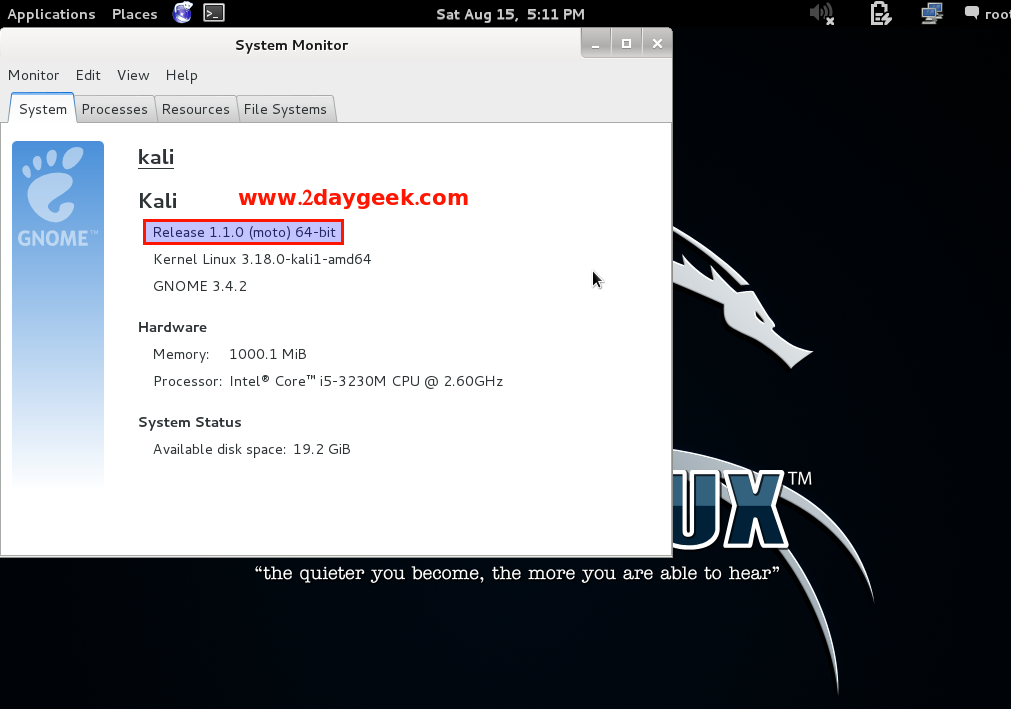Update Software Kali Linux
I am using 32-bit kali linux on my toshiba qosmio x505-q887. Whenever i try to update using 'apt-get update' it following output: Ign cdrom://Debian GNU/Linux 7.0 Kali - Official Snapshot i386 LIVE/INSTALL Binary 20130723-13:42 kali Release.gpg Ign cdrom://Debian GNU/Linux 7.0 Kali - Official Snapshot i386 LIVE/INSTALL Binary 20130723-13:42 kali Release Err cdrom://Debian GNU/Linux 7.0 Kali - Official Snapshot i386 LIVE/INSTALL Binary 20130723-13:42 kali/contrib i386 Packages Please use apt-cdrom to make this CD-ROM recognized by APT. Apt-get update cannot be used to add new CD-ROMs Err cdrom://Debian GNU/Linux 7.0 Kali - Official Snapshot i386 LIVE/INSTALL Binary 20130723-13:42 kali/main i386 Packages Please use apt-cdrom to make this CD-ROM recognized by APT. Apt-get update cannot be used to add new CD-ROMs Err cdrom://Debian GNU/Linux 7.0 Kali - Official Snapshot i386 LIVE/INSTALL Binary 20130723-13:42 kali/non-free i386 Packages Please use apt-cdrom to make this CD-ROM recognized by APT. 1) Click Applications - System Tools - Preferences - Software Settings 2) Choose the Software Sources Tab 3) Uncheck the deb cdrom.That should work. An alternative way to do this would be to open a terminal, type 'leafpad /etc/apt/sources.list' or 'sudo leafpad /etc/apt/sources.list' (if you are a non-root user). At the top of the sources.list file there should be two lines that say 'deb cdrom' or something similar.
Put a # sign in front of those two lines. It should look something like this after: #deb cdrom:Debian GNU/Linux 7.0 Kali - Official Snapshot amd64 LIVE/INSTALL Binary 20130425-10:30/ kali contrib main non-free #deb cdrom:Debian GNU/Linux 7.0 Kali - Official Snapshot amd64 LIVE/INSTALL Binary 20130425-10:30/ kali contrib main non-free then click save in leafpad and then try apt-get update again.
Kali Linux is a flavor of Linux targeted at digital forensics experts and penetration (pen) testers. It includes over 400 pen-testing programs, and it is the primary tool used by ethical hackers. Using Kali Linux, certified ethical hackers can test networks on their organizations' behalves, to see if they're vulnerable to outside attacks. This course will give prospective ethical hackers a short overview of the tools in Kali Linux. Cybersecurity expert Malcolm Shore shows how to set up a virtual environment for testing, configure Kali Linux, and install toolsets for information gathering, vulnerability assessment, password and hash cracking, and target exploitation. Because businesses are connected, they are also exposed.
Vulnerability testing helps organizations limit that exposure. This course will help you explore the careers, techniques, and tools behind ethical hacking—one of the most competitive and sought-after IT security skills. Instructor. Malcolm Shore is a cybersecurity expert who spent ten years as a director at New Zealand's GCSB. Shore was the principal security officer at the Australian National Broadband Network Company and the director of education and community relations for the Australian Information Security Association. He's currently a technical director at BAE Systems Applied Intelligence, and an educator in the fields of forensics, information warfare, security management, and applied cryptography.
He holds a PhD in information security. Watch this course anytime, anywhere. Course Contents. Introduction Introduction.
Through on this article you will get idea on how to install Kali linux 2.0 upgrade. Kali Linux 2.0 Release notes and upgrade steps. New software update.
We are delighted to announce the immediate availability of Kali Linux 2017.3, which includes all patches, fixes, updates, and improvements since our last release. We are delighted to announce the immediate availability of Kali Linux 2017.3, which includes all patches, fixes, updates, and improvements since our last release.

Kali Linux Commands

1. Setting Up the Virtual Lab 1.
Setting Up the Virtual Lab. 2. Introducing Kali 2. Introducing Kali. 3. Information Gathering (Understanding the Target) 3.
Kali Linux Iso
Information Gathering (Understanding the Target). 4. Vulnerability Analysis 4.
Vulnerability Analysis. 5. Passwords and Hashes 5. Passwords and Hashes.
6. Exploiting Targets 6. Exploiting Targets.
Conclusion Conclusion.